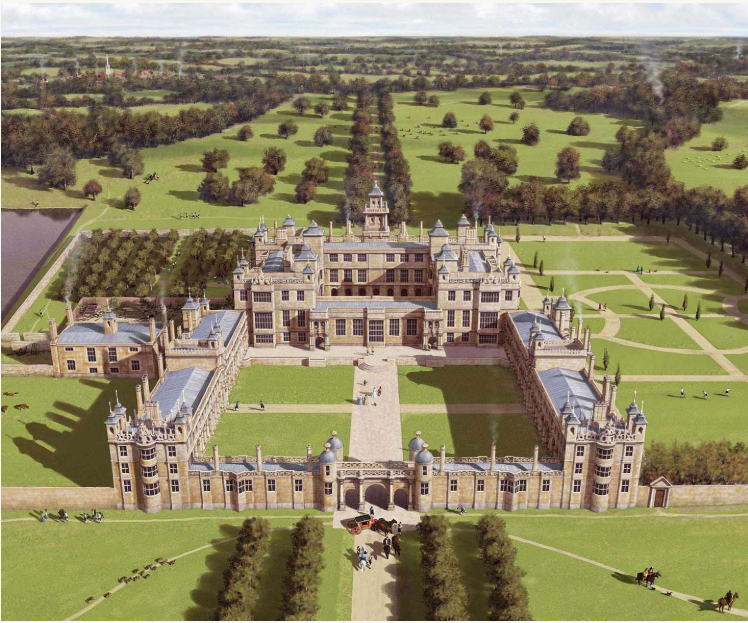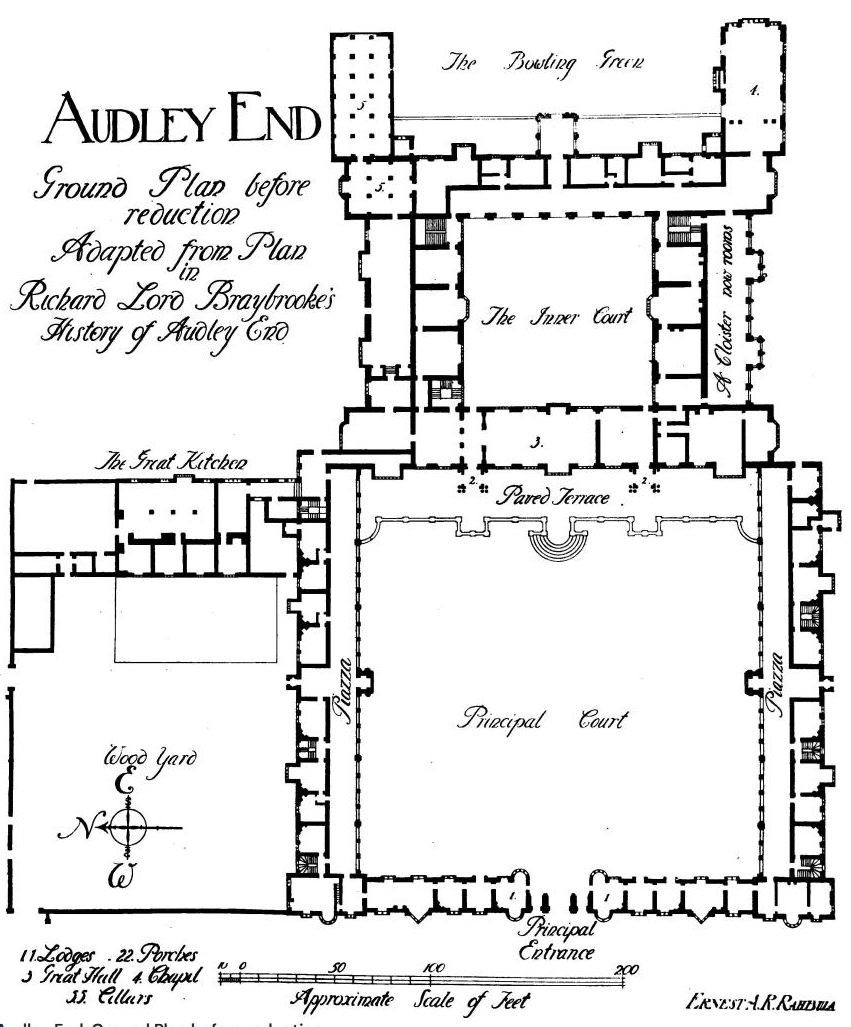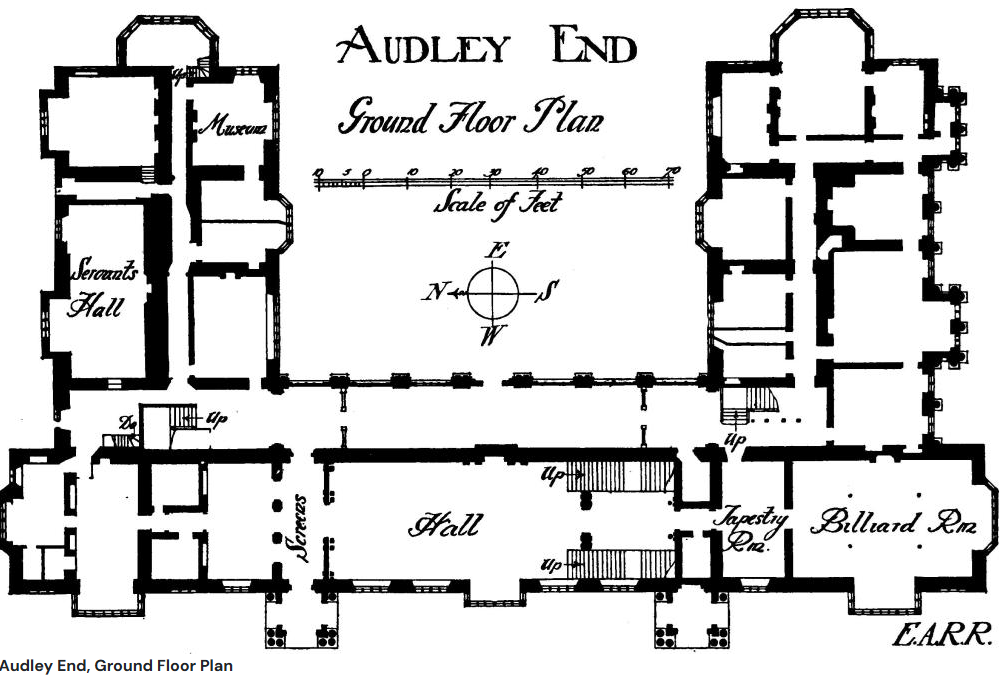Webmaster Notes
There are too many reference links on this page. I started off with a page on Saffron Walden and then spawned off a page on Audley End (This page). I also have a page on Walden Abbey
The intention was to have this page about the Abbey and links to Geofrey de Mandeville but I have links to those that are connected to the Jacobean Hall.
Audley End, Saffron Walden
Audley End House and Gardens is definitely worth a visit if you are in the Belchamp Walter area. If you are staying in Belchamp Walter Audley End is approximately 90 mins drive.
The house and gardens are close to Saffron Walden and is an English Heritage location.
English Heritage
There is a lot of information on the English Heritage website if you know where to look. The link to British Heritage Online (BHO) - a lot of the information is about Saffron Walden.
Audley End was one of the greatest houses of early 17th-century England. In about 1605–14 Thomas Howard, 1st Earl of Suffolk, took an earlier house created by his grandfather Lord Audley on the site of Walden Abbey, and rebuilt it on the scale of a royal palace. Robert Adam transformed this house for Sir John Griffin Griffin in the 1760s, while Lancelot ‘Capability’ Brown remodelled the grounds, to create one of England’s finest landscape gardens.
Top
Thomas Audley, 1st Baron Audley of Walden "Queen Slayer"
Thomas Audley was "assigned" the ruins or remains of the Abbey of Walden probably by Sir Richard Rich after the Dissolution of the Monasteries (between 1536 and 1541, by Henry VIII). Rich was Lord Chancellor of England from 1547 to 1552. Audley was chancellor just after the Dissolution, Rich was the administrator of the "assigment" of monastic property.
Thomas Audley, 1st Baron Audley of Walden KG, PC, KS, JP (c. 1488 – 30 April 1544), was an English barrister and judge who served as Lord Chancellor of England from 1533 to 1544.
Audley built a country house in what remained of the Abbey church.
Thomas Audley was heavily involved with the affairs (pun intended) of Henry VIII. The Audley End guide book says that he was involved.
Thomas Howard, 1st Earl of Suffolk
The Wikipedia page says:
Thomas Howard, 1st Earl of Suffolk, KG, PC (24 August 1561 – 28 May 1626), of Audley End House in the parish of Saffron Walden in Essex, and of Suffolk House[1] near Westminster, a member of the House of Howard, was the second son of Thomas Howard, 4th Duke of Norfolk, by his second wife Margaret Audley, the daughter and eventual sole heiress of Thomas Audley, 1st Baron Audley of Walden, of Audley End.
The English Heritage site says:
Ownership of Audley’s house descended to Thomas Howard, 4th Duke of Norfolk, who was executed in 1572 for conspiring with Mary, Queen of Scots, against Elizabeth I (r.1558–1603). The duke’s second son, Thomas (1561–1626), redeemed the family reputation, gaining Elizabeth's confidence and being created Baron Howard de Walden and a Knight of the Garter.
The execution of the 4th Duke is also associated with Edward de Vere who married Anne Cecil, Daughter of William Cecil, 1st Baron Burghley.
On the accession of James VI of Scotland as James I of England in 1603, Howard was made Earl of Suffolk and appointed Lord Chamberlain. In 1614 he became Lord Treasurer, but four years later was convicted of corruption, extortion and bribery – the embezzled money had helped to pay off his debts. He and the countess escaped with a heavy fine and retired in disgrace to Audley End, the main cause of their financial problems.
Plan from Richard Lord Braybooke
Sir John Griffin Griffin
He was born John Griffin Whitwell, the son of William Whitwell by his wife Anne Griffin, sister and sole heiress of Edward Griffin, 3rd Baron Griffin of Braybrooke, and granddaughter of James Howard, 3rd Earl of Suffolk and 3rd Baron Howard de Walden (1619–1689).
Audley End was transformed in the reign of George III (1760's) by Robert Adam for Sir John Griffin Griffin.
Richard Aldworth Neville (1750–1825),
On Lord Howard’s death Audley End and his subsidiary title of Baron Braybrooke passed to Richard Aldworth Neville (1750–1825), a descendant of Lady Portsmouth's first husband. Neville’s eldest son, Richard (1783–1858; from 1825 3rd Baron Braybrooke), a scholar and antiquarian, embarked on the last major reworking of Audley End, after taking over the house from his father in 1820.
The 3rd Lord Braybrooke’s aim was to recover the Jacobean character of the house. Surviving 17th-century elements were repaired and stripped of paint, and new work in the same style was added, but pragmatically much of Adam’s work was retained. His ground-floor reception rooms (except the library) were adapted to form the new state apartment, and a new suite of reception rooms was created in its place on the first floor of the south wing.
Braybrooke, Richard Griffin - The History of Audley End - 1783-1858
Braybrooke's history of the house at Audley End shows that he was of my own heart. His original intention was to record anything related to Audley End, he ended up extending this to the "remainder of the parish".
He says preface:
A few observations upon the arrangement of the following pages may be necessary, though no uniform plan in this respect is prescribed to topographers. The reader, then, should bear in mind, that the History of Audley End was originally my only object, some of the sheets having been printed off before I had contemplated extending the work to the remainder of the parish of Walden, and even at a later period it was supposed that a few supplementary notices would be sufficient for the purpose
Polish Section of the Special Operations Executive.
Capability Brown




